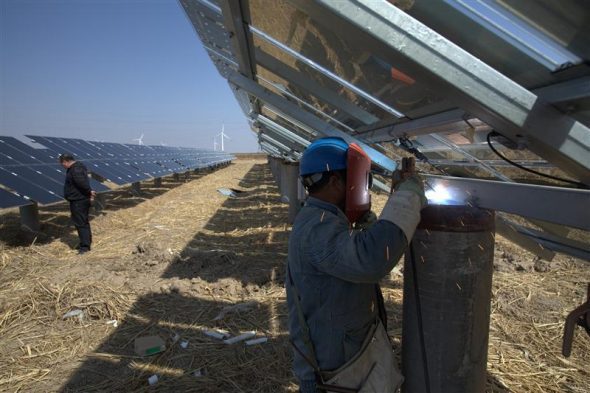
China’s wind and solar industry is projected to expand fivefold by 2030, displacing fossil energy sources by the equivalent of 300 million tonnes of standard coal and saving enough water for the needs of 200 million people, according to a new report.
But China’s energy transition is already well underway.
Coal consumption has fallen for three years running, and the share of non-fossil energies rose to 13% last year.
So what’s fuelling this historic shift?
1) Investment potential
In 2015, wind and solar PV power generation contributed RMB 0.31 trillion to the national GDP.
This figure is expected to leap to RMB 1.57 trillion by 2030 — roughly 1.1% of China’s GDP.
Moreover, between 2016 and 2030, wind and solar PV power are projected to attract RMB 5.4 trillion in total investment — which is more than $750 billion at today’s exchange rate.
2) Better grid connection
In recent years, China’s government has poured resources into addressing energy poverty.
Between 2013 and 2015, the government spent a total of RMB 24.78 billion on expanding electricity access.
But while only 16.5% of that money was spent on off-grid solar PV installations, the technology was responsible for 43.4% of new energy access achieved in China in that period.
In China, off-grid solar has been shown to be the most economical way to address energy poverty —and the country’s experience offers a model of how this is possible worldwide.
3) Half a million jobs
In 2015, China’s wind and solar PV industries created direct job opportunities for roughly 450,000 people.
By 2030, this figure is projected to jump by more than fourfold, to 2.4 million.
Likewise, the number of indirect job opportunities (such as transportation and raw materials production) is set to multiply from 1 million in 2015 to 5.3 million in 2030.
This means that by 2030, China’s wind and solar PV industries will provide employment to an estimated 7.7 million people — for comparison, Ireland’s population is less than 5 million.
4) Tangible environmental benefits
Replacing dirty coal power with emissions-free renewable energy brings huge financial gains.
Today’s report found that in 2015 China’s wind and solar PV added approx 0.16 RMB/kWh in external environmental benefits, such as emissions reductions and public health savings.
By 2030, the external environmental benefits of China’s wind and solar PV are expected to reach 0.3 RMB/kWh, which means that they’ll amount to RMB 456 billion ($66bn) as a result of replacing fossil energy sources.
5) The water crisis
Because China’s coal-fired power plants both consume massive amounts of water and are concentrated in water-scarce areas, they present a particular threat to the country’s arid northern provinces.
In 2015, the development of wind and solar PV reduced water consumption by approximately 0.57 billion m3.
By 2030 wind and solar energy is projected to save 3.6 billion m3 of water per year, equivalent to the annual basic needs of 200 million people.
Solar PV and wind allowed for the preservation of approximately 1 billion m3 of water in northwest China, where water resources are extremely scarce.
Source: EnergyDesk. Reproduced with permission.







